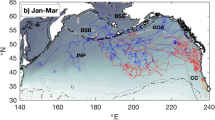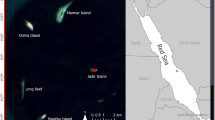Abstract
The biology of the endangered leatherback turtle (Dermochelys coriacea) at sea is poorly understood. As research has been almost exclusively limited to studies of nesting females, the movements of male turtles and the timing and location of mating activity have remained unknown. We report on the first deployments of satellite tags on male leatherbacks. Male migration to and residency in waters adjacent low-latitude nesting beaches in the western Atlantic suggest that this is where mating occurs, and return migration to these areas reveals male fidelity for breeding sites. Rate of travel decreased markedly after arriving in coastal breeding areas, where males remained for up to 96 days before assuming northward migrations. The initiation of these northward migrations coincided with peak nesting activity in adjacent nesting colonies. Data from satellite-linked time-depth recorders attached to two males revealed diel dive patterns in breeding areas and marked differences in diving behaviour between migratory and breeding periods in one turtle. When male turtles were in waters adjacent nesting colonies, their movements differed from those reported for nesting females, with females ranging farther from shore. Our results suggest that male leatherbacks may be vulnerable to entanglement in coastal fishing gear in waters adjacent nesting beaches.








Similar content being viewed by others
References
Booth J, Peters JA (1972) Behavioural studies on the green turtle (Chelonia mydas) in the sea. Anim Behav 20:808–812
Boulon RH, Dutton PH, McDonald DL (1996) Leatherback turtles (Dermochelys coriacea) on St. Croix, U.S. Virgin Islands: fifteen years of conservation. Chelon Conserv Biol 2:141–147
Carr T, Carr N (1986) Dermochelys coriacea (leatherback sea turtle) copulation. Herpetol Rev 17:24–25
Chacón D (1999) Anidación de la tortuga Dermochelys coriacea (Testudines: Dermochelyidae) en playa Gandoca, Costa Rica (1990 a 1997). Rev Biol Trop 47:225–236
Chacón D, McLarney W, Ampie C, Venegas B (1996) Reproduction and conservation of the leatherback sea turtle Dermochelys coriacea (Testudines: Dermochelyidae) on Gandoca Beach, Costa Rica. Rev Biol Trop 44:853–860
Chevalier J (2001) Etude des captures accidentelles de tortues marines liées à la pêche au filet dérivant dans l’ouest Guyanais. Office National de la Chasse at de la Faune Sauvage, Paris
Eckert KL (2001) Status and distribution of the leatherback sea turtle, Dermochelys coriacea, in the Wider Caribbean Region. In: Eckert KL, Abreu Grobois FA (eds) Proceedings of the regional meeting: “Marine turtle conservation in the Wider Caribbean Region: a dialogue for effective regional management,” Santo Domingo, 16–18 November 1999. WIDECAST, IUCN/SSC Marine Turtle Specialist Group, WWF and UNEP–Caribbean Environment Program, Washington, DC, pp 24–31
Eckert KL, Eckert SA (1988) Pre-reproductive movements of leatherback sea turtles (Dermochelys coriacea) nesting in the Caribbean. Copeia 1988:400–406
Eckert SA (2002) Swim speed and movement patterns of gravid leatherback sea turtles (Dermochelys coriacea) at St. Croix, U.S. Virgin Islands. J Exp Biol 205:3689–3697
Eckert SA, Eckert KL, Ponganis P, Kooyman GL (1989) Diving and foraging behaviour of leatherback sea turtles (Dermochelys coriacea). Can J Zool 67:2834–2840
Eckert SA, Liew H-C, Eckert KL, Chan E-H (1996) Shallow water diving by leatherback turtles in the South China Sea. Chelon Conserv Biol 2:237–243
Ferraroli S, Georges J-Y, Gaspar P, Le Maho Y (2004) Where leatherback turtles meet fisheries. Nature 429:521–522
FitzSimmons NN, Limpus CJ, Norman JA, Goldizen AR, Miller JD, Moritz C (1997) Philopatry of male marine turtles inferred from mitochondrial DNA markers. Proc Natl Acad Sci U S A 94:8912–8917
Frick MG, Slay CK, Quinn CA, Windham-Reid A, Duley PA, Ryder CM, Morse LJ (2000) Aerial observations of courtship behavior in loggerhead sea turtles (Caretta caretta) from southeastern Georgia and northeastern Florida. J Herpetol 34:153–158
Girondot M, Fretey J (1996) Leatherback turtles, Dermochelys coriacea, nesting in French Guiana, 1978–1995. Chelon Conserv Biol 2:204–208
Godfrey MH, Barreto R (1998) Demochelys coriacea (leatherback sea turtle) copulation. Herpetol Rev 29:38–39
Godley BJ, Broderick AC, Frauenstein R, Glen F, Hays GC (2002) Reproductive seasonality and sexual dimorphism in green turtles. Mar Ecol Prog Ser 226:125–133
Hasting M (2003) A conservation success: leatherback turtles in the British Virgin Islands. Mar Turtle Newslett 99:5–7
Hays GC, Akesson A, Godley BJ, Luschi P, Santadrian P (2001) The implications of location accuracy for the interpretation of satellite tracking data. Anim Behav 61:1035–1040
Hays GC, Houghton JDR, Isaacs C, King RS, Lloyd C, Lovell P (2004a) First records of oceanic dive profiles for leatherback turtles, Dermochelys coriacea, indicate behavioural plasticity associated with long-distance migration. Anim Behav 67:733–743
Hays GC, Houghton JDR, Myers AE (2004b) Pan-Atlantic leatherback turtle movements. Nature 429:522
Hughes GR, Luschi P, Mencacci R, Papi F (1998) The 7000-km oceanic journey of a leatherback turtle tracked by satellite. J Exp Mar Biol Ecol 229:209–217
James MC (2004) Dermochelys coriacea (leatherback sea turtle) migration and dispersal. Herpetol Rev 35:264
James MC, Ottensmeyer CA, Myers RA (2005) Identification of high-use habitat and threats to leatherback sea turtles in northern waters: new directions for conservation. Ecol Lett 8:195–201
Jessop TS, Hamann M, Limpus CJ (2004) Body condition and physiological changes in male green turtles during breeding. Mar Ecol Prog Ser 276:281–288
Keinath JA, Musick JA (1993) Movements and diving behaviour of a leatherback turtle, Dermochelys coriacea. Copeia 1993:1010–1017
Lazell JD (1980) New England waters: critical habitat for marine turtles. Copeia 1980:290–295
Lee Lum L (2003) An assessment of incidental turtle catch in the gillnet fishery in Trinidad and Tobago, West Indies. (Project #00-026-005) Institute of Marine Affairs, Trinidad
Limpus CJ (1993) The green turtle, Chelonia mydas, in Queensland: breeding males in the southern Great Barrier Reef. Wildl Res 20:513–523
Luschi P, Sale A, Mencacci R, Hughes GR, Lutjeharms JRE, Papi F (2003) Current transport of leatherback turtles (Dermochelys coriacea) in the ocean. Proc R Soc Lond B (Suppl) 270:S129–S132
Martin KE, James MC (2005) Conserving sea turtles in Canada: successful community-based collaboration between fishers and scientists. Chelon Conserv Biol 4:899–907
Morreale SJ, Standora EA, Spotila JR, Paladino FV (1996) Migration corridor for sea turtles. Nature 384:319–320
Plotkin PT, Owens DW, Byles RA, Patterson R (1996) Departure of male olive ridley turtles (Lepidochelys olivacea) from a nearshore breeding ground. Herpetologica 52:1–7
Pritchard PCH (1976) Marine turtle migrations. Copeia 1976:752–753
Pritchard PCH (1982) Nesting of the leatherback turtle, Dermochelys coriacea, in Pacific Mexico, with a new estimate of the world population status. Copeia 1982:741–747
Southwood AL, Andrews RD, Lutcavage ME, Paladino FV, West NH, George RH, Jones DR (1999) Heart rates and diving behaviour of leatherback sea turtles in the eastern Pacific Ocean. J Exp Biol 202:1115–1125
Spotila JR, Dunham AE, Leslie AJ, Steyermark AC, Plotkin PT, Paladino FV (1996) Worldwide population decline of Dermochelys coriacea: are leatherback turtles going extinct? Chelon Conserv Biol 2:209–222
Troëng S, Chacón D, Dick B (2004) Possible decline in leatherback turtle Dermochelys coriacea nesting along the coast of Caribbean Central America. Oryx 38:395–403
Vincent C, McConnell BJ, Ridoux V, Fedak MA (2002) Assessment of Argos location accuracy from satellite tags deployed on captive grey seals. Mar Mamm Sci 18:156–166
Acknowledgements
We thank members of the Nova Scotia Leatherback Turtle Working Group for their collaboration, and B. Fricker, H. Fricker, K. Martin, and B. Mitchell for invaluable assistance with fieldwork. We are grateful to C. Harvey-Clark for veterinary advice and W. Blanchard and C. A. Ottensmeyer for technical assistance. We thank M. Lutcavage for initiating tagging work in Nova Scotia. Thanks also to D. Chacón (Association ANAI, Costa Rica) and Nature Seekers (Trinidad) for providing nesting survey data. Funding was provided by National Marine Fisheries Service (USA), Fisheries and Oceans Canada, World Wildlife Fund Canada, Environment Canada, Canadian Wildlife Federation, Wider Caribbean Sea Turtle Conservation Network, Future of Marine Animal Populations, George Cedric Metcalf Charitable Foundation, and the Natural Sciences and Engineering Research Council of Canada (grants to R.A.M. and scholarship to M.C.J.). This research was conducted under license by Fisheries and Oceans Canada.
Author information
Authors and Affiliations
Corresponding author
Additional information
Communicated by R.J. Thompson, St. John’s
Rights and permissions
About this article
Cite this article
James, M.C., Eckert, S.A. & Myers, R.A. Migratory and reproductive movements of male leatherback turtles (Dermochelys coriacea). Marine Biology 147, 845–853 (2005). https://doi.org/10.1007/s00227-005-1581-1
Received:
Accepted:
Published:
Issue Date:
DOI: https://doi.org/10.1007/s00227-005-1581-1




